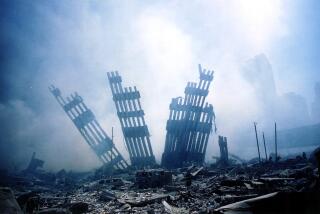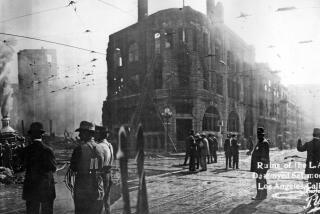Legwork, Luck Closed Net Around Bombing Suspect : Manhunt: A mysterious informer’s tip capped an intense search for alleged mastermind of trade center blast.
WASHINGTON — Shortly after 10 a.m. Tuesday, Pakistani and American agents burst into Room 16 of Islamabad’s Su-Casa guest house, a whitewashed residential structure with stately Greek pillars and a balcony. Stretched out on a bed was a man in his late 20s, a fugitive renowned for his cockiness and cunning but clearly startled by the agents’ arrival. Within minutes, they had bundled him out of the small, musty room and through Su-Casa’s white marble entrance.
“It was like a hurricane, a big panic,” recalled Pakistani businessman Khaled Sheikh, a lodger at the guest house. “He was shouting: ‘Why are you taking me? I am innocent! Show me papers if you are going to arrest me! Who are you?’
“No one listened to him. They took him without his shoes. His eyes were blindfolded, his head was covered, his arms and legs were tied.”
Within 36 hours, the young man who goes by the name of Ramzi Ahmed Yousef as well as assorted other aliases was locked up in New York’s Metropolitan Correction Center to face charges of masterminding the 1993 bombing of the World Trade Center in Manhattan.
One of the most intensive manhunts ever conducted by the United States was over.
In the end, it was not only the legwork of allied intelligence services that led to the apprehension of one of the world’s most sought-after terrorists, a man who managed to evade a worldwide dragnet for almost two years.
According to detailed U.S. and Asian accounts of events leading up to Yousef’s capture, it also involved a fair amount of luck.
The net was finally closed by a walk-in informant. Witness accounts indicated the tipster was Istiaque Parker, a movie-loving South African Muslim who lived across from Su-Casa. Parker reportedly was sighted there with Yousef and also at the U.S. Embassy in Islamabad, where authorities were told of Yousef’s whereabouts.
An influential Pakistani daily, the News, reported today that Parker had been the tipster and that he had been whisked away with his family by the FBI and was now in hiding under federal protection somewhere in the United States.
The newspaper, quoting “official sources,” said Parker had been divulging information about other terrorist activities unrelated to the trade center bombing. It gave no details, and U.S. officials in Islamabad were tight-lipped.
But there are still far more questions than answers about Yousef, according to U.S. and foreign officials. Near the top of the list: Does the trade center bombing trail end with Yousef, or will his capture lead to the involvement of others, perhaps even a foreign government?
“From what we’ve learned about Yousef since the World Trade Center, we believe he has the resources and range of contacts to be more than just an alienated and angry Muslim out for revenge,” said one official who requested anonymity. “He’s not a misfit like the others,” he said, referring to the four men convicted last March in the bombing trial.
Yousef, the official said, “may very well turn out to be the Abu Nidal of the 1990s,” a reference to the renegade Palestinian who carried out terrorist attacks for other groups as well as for his own movement. “The operations he appears to have planned are certainly as lethal as Abu Nidal’s.”
Because Yousef’s extensive operations and travels would have required significant funding, three scenarios are likely: He might have been sponsored by a foreign government, functioned as a terrorist-for-hire or received financial support from a network of like-minded Islamic militants, contend counterterrorism specialists.
“The bottom line is that we don’t know,” said a senior U.S. official. “These are the early days.”
If he was sponsored by a foreign government, officials said, the leading contender would be Iraq, based on an admittedly disparate array of circumstantial evidence.
Baghdad, for example, has long begrudged the United States for its humiliating and swift defeat in the Persian Gulf War. In addition, Su-Casa is just down the street from the Iraqi ambassador’s residence. Yousef reportedly arrived at Su-Casa without a reservation, on foot and with an escort.
Establishing even the most basic information about Yousef is problematic. An FBI “wanted” poster says he could be a citizen of Iraq, Kuwait or the United Arab Emirates. Yousef’s accent has led some to speculate that he might be of Palestinian descent.
Yousef, the name on his Iraqi passport when he arrived in the United States in 1992, is equally ambiguous. Many U.S. officials think it could be an alias: The suspect is a devout Muslim, but Yousef (Joseph in English) is generally used by Christian Arabs.
Even if Yousef turns state’s evidence and implicates others, it might take weeks or even months to corroborate his story.
Yousef was last reliably sighted during a five-month stay in the United States. He gained entry on Sept. 1, 1992, without a visa by applying for political asylum; he was allowed to stay while his case was pending. Evidence from the World Trade Center bombing trial shows he quickly assembled a cell of Muslim fanatics, many of whom worshiped at the New Jersey mosque of the blind Egyptian Sheik Omar Abdel Rahman.
In less than six months, Yousef’s militant cell planned and executed the deadliest act of terrorism on U.S. soil. The Feb. 26, 1993, trade center bombing killed six people, injured more than 1,000, and caused $500 million in damage.
Using another alias, Yousef slipped away that night on a Pakistan International Airways flight to Karachi, Pakistan, without telling the co-conspirators who were left to take the fall, authorities said. The flight had been booked more than two weeks in advance.
After his arrival in Pakistan, Yousef disappeared, and U.S. and Interpol investigators began slogging their way through false starts and erroneous sightings.
From Pakistan, Yousef was reported to have assumed other identities and to have traveled to various Mideast countries, notably Iraq. He was also said to have disappeared across the porous border with Afghanistan, where he has close ties from the time he spent training and fighting alongside the Afghan moujahedeen .
Yousef’s trail began to heat up only last month, discovered by Asian officials who were looking for something else entirely.
As part of a security clampdown before the arrival of Pope John Paul II in the Philippines, government agents were monitoring several individuals and groups, Philippine sources said. The government’s security plans had been tightened after a small bomb exploded on a Philippine Airlines flight to Japan in December, killing one passenger and injuring six.
Among the sites under surveillance was an apartment about a block from the Papal Nunciature. In the days before the Pope’s arrival, Philippine agents raided the apartment. They arrested two men and discovered a wealth of material about multiple terrorist plots, including one involving the Pope and others involving U.S. air carriers in the Far East.
“It was stunning stuff--routes of the Pope’s entourage, priests’ clothing, Bibles, crosses and key elements in making bombs, like timing devices,” a U.S. official said. “Based on this, there could be no doubt of their intentions.”
The most important piece of evidence was an encoded computer disk that laid out elements of the various attacks, according to Philippine and American sources.
Although the plot against the Pope drew most of the initial attention, it could have been a decoy or secondary objective, U.S. officials now suspect. The investigation suggests the principal target was one or more U.S. airlines.
The data on the disk was a pivotal factor in Washington’s decision to issue a blunt warning last month about bomb threats to U.S. carriers in Asia, a warning that was repeated after Yousef’s arrest.
In the hunt for Yousef, one piece of evidence found in the raided Manila apartment has turned out to be among the most puzzling, Philippine investigators say.
It is Yousef’s fingerprint.
U.S. officials adamantly assert that Yousef was in the Philippines last month. They believe that he might have been scared off just before or after the apartment raid and fled the country.
But Philippine police say they strongly doubt that Yousef ever got into the country. Some contend that he was among dozens of young men who fit an Arab or Muslim profile and consequently were turned back at the airport before the papal visit.
U.S. and Philippine officials will not say where the fingerprint was found. It matched a set of Yousef prints taken off a manual on making explosives, which was used in the New York bombing.
Whether Yousef was actually in the Philippines or not, investigators agree that he was a central figure in the terrorist schemes. The two men arrested in the incident are widely believed to be affiliated with a third militant cell built by Yousef, or on his behalf.
Although Yousef was not caught, the evidence prompted officials to alert security forces throughout Asia.
Unknown to U.S. authorities at the time, Yousef was in Thailand earlier this month, allegedly plotting to bomb a U.S. airliner. He apparently aborted the mission after learning that security at the Bangkok airport were tighter than anticipated, U.S. sources said. The sources said the scheme was not uncovered until after his capture.
When that plot fell apart, Yousef flew back to Pakistan. Islamabad was intended to be a brief stopover, authorities believe. He checked into the two-story Su-Casa under the name Ali Mohammed.
“He was heading back to Peshawar, which is the Wild West, with drug smuggling in the open, very tribal, and with no government,” said a law enforcement source.
Yousef’s plans were foiled by an informant believed to have been seeking a promised $2-million reward for information leading to Yousef’s capture. Authorities say Yousef was under surveillance from the moment of his return.
After agents nabbed Yousef in Room 16, they found two toy cars filled with explosives, cotton wool soaked in explosives and other evidence in two suitcases he had refused to allow a porter to carry to his room, according to Pakistani and U.S. sources. Agents spent the rest of the day sorting through his room and belongings.
“We still have a lot we want and need to know about this guy before we can determine the full extent of the damage he’s done or what he’s left in place elsewhere,” said a U.S. counterterrorism official.
In Pakistan, meanwhile, little has been learned about the mysterious Parker.
Shopkeepers recount that U.S. and Pakistani agents crossed the street from the Su-Casa and walked upstairs to Parker’s apartment, where they remained more than an hour, apparently using cameras and video equipment.
South African diplomats said that Parker had been in Pakistan about three years. Although he once had to borrow money for a trip to South Africa, he flew to Bangkok a few months ago, the diplomats said.
Wright reported from Washington and Dahlburg from New Delhi. Staff writer Ronald J. Ostrow in Washington and special correspondent Jennifer Griffin in Islamabad contributed to this story.
More to Read
Sign up for Essential California
The most important California stories and recommendations in your inbox every morning.
You may occasionally receive promotional content from the Los Angeles Times.










